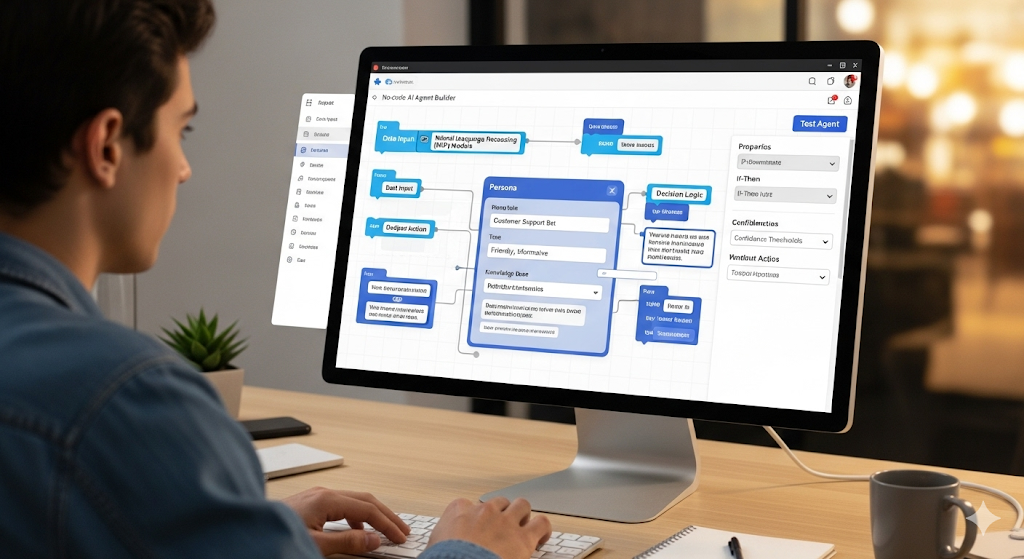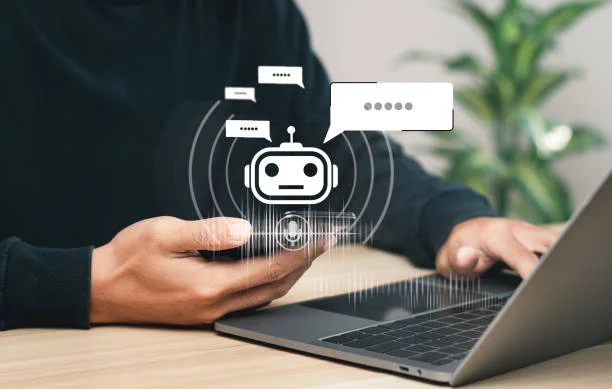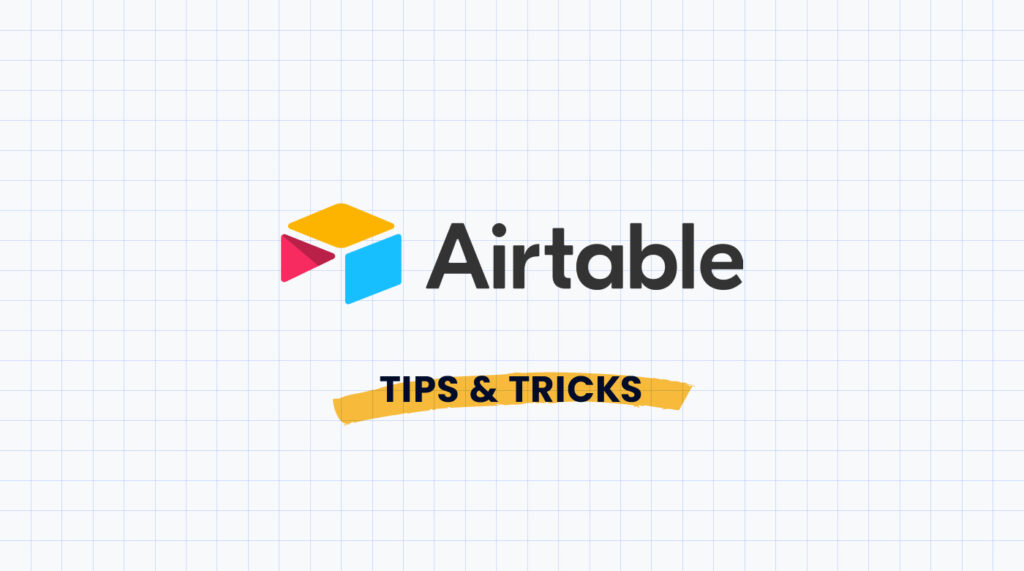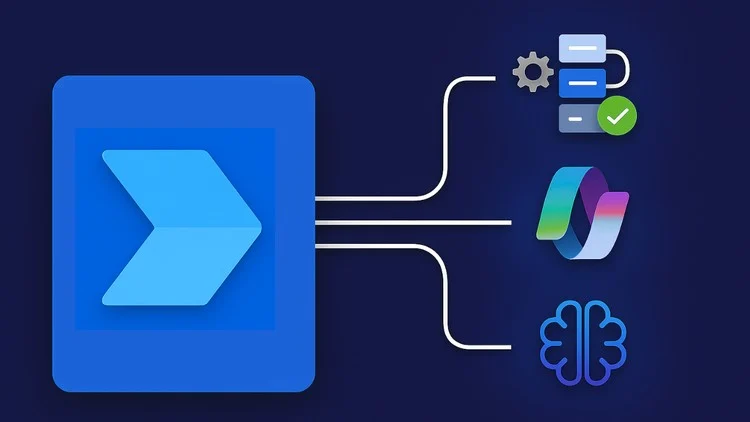
Understanding AI Agent Builder Platforms
What is an AI Agent and Why Build One?
An AI agent is a software program capable of autonomously performing tasks based on a defined set of goals and instructions. Unlike simple scripts, AI agents leverage technologies like machine learning and natural language processing to adapt and learn from their interactions with their environment, making them increasingly effective over time. Think of them as automated assistants that can manage emails, schedule meetings, or even analyze data – all without direct human intervention. In our experience, the most successful AI agents are those built with clearly defined goals and robust feedback loops.
Why build your own? Creating a bespoke AI agent offers several advantages. Firstly, you gain precise control over its functionality and data handling, crucial for sensitive information or specific business processes. Secondly, building your own agent can be significantly more cost-effective than relying on pre-built solutions, especially when dealing with large-scale or highly specialized tasks. Consider a marketing team wanting to automatically tailor email campaigns based on individual customer data; a custom AI agent could achieve this far more efficiently than adapting a generic platform. Finally, the process of designing and building your agent fosters a deeper understanding of its capabilities and limitations, which can lead to further innovation within your organization.
Key Features of Top AI Agent Builder Platforms
Top AI agent builder platforms share several core features, but their implementation and capabilities vary significantly. In our experience, the most successful platforms offer intuitive visual workflows, allowing users to design agent behavior without extensive coding. Look for drag-and-drop interfaces for connecting different modules (like data sources, NLP models, and actions) and creating complex agent logic. Another critical feature is robust integration capabilities, enabling seamless connection to existing systems and data repositories, including CRMs, databases, and APIs. A platform lacking this flexibility will severely limit your agent’s potential.
A common mistake we see is overlooking the importance of built-in debugging and monitoring tools. Effective platforms provide real-time dashboards displaying key agent metrics, enabling users to identify and resolve issues promptly. For example, one platform we tested excelled in this area by visualizing conversation flows and flagging problematic interactions—a significant time-saver. Furthermore, consider the platform’s support for various AI models and its ability to handle different data types. The best platforms offer a range of choices, accommodating diverse agent needs and ensuring compatibility with your specific data structures. Prioritize platforms with active communities and responsive customer support to navigate any challenges you encounter.
No-Code vs. Low-Code vs. Traditional Development for AI Agents
Choosing the right development approach for your AI agent significantly impacts the project’s complexity, cost, and time-to-market. No-code platforms offer a visual, drag-and-drop interface, ideal for beginners or rapid prototyping. In our experience, these platforms excel when building simpler agents with pre-built functionalities, like chatbots handling basic customer service requests. However, they may lack the flexibility for highly customized or complex AI agents. A common pitfall is underestimating the limitations of pre-built components, leading to unexpected constraints later in development.
Conversely, low-code platforms provide more control and customization options while still simplifying the development process. They often involve some coding, typically for integrating specialized functionalities or connecting to unique data sources. This approach suits users with some programming experience or those building more sophisticated agents requiring bespoke integrations. For instance, a low-code platform might allow you to easily connect your agent to a specific CRM system, while a no-code platform may not support that level of integration. Finally, traditional development using languages like Python offers complete control but demands significant coding skills and development time. This route is necessary for extremely complex agents or those requiring unique AI models, but it’s the most resource-intensive option. Selecting the right approach depends entirely on your technical expertise and the complexity of your desired AI agent.
Benefits of Using an AI Agent Builder Platform
Leveraging an AI agent builder platform offers significant advantages over building from scratch. Firstly, you drastically reduce development time and costs. In our experience, building a complex AI agent from the ground up can take months, requiring specialized coding skills and substantial infrastructure investment. AI agent builder platforms, however, often provide pre-built templates and modules, allowing you to quickly assemble and deploy functional agents in a fraction of the time. This translates to faster iteration and quicker time-to-market for your projects.
Secondly, these platforms democratize access to AI technology. Without needing extensive programming knowledge, you can focus on the core logic and functionality of your agent, rather than getting bogged down in intricate code details. For example, a marketing team could readily create an agent for lead generation without requiring dedicated software engineers. This accessibility leads to more widespread innovation and empowers individuals and smaller teams to compete effectively with larger organizations. Finally, many platforms offer seamless integration with existing systems, simplifying data flow and management, further streamlining the development process. Choosing the right platform can be a game changer, impacting not just the efficiency but also the overall success of your AI project.
Choosing the Right AI Agent Builder Platform for Your Needs

Factors to Consider When Selecting a Platform
Selecting the ideal AI agent builder platform requires careful consideration of several key factors. Firstly, ease of use is paramount, especially for beginners. Intuitive interfaces with drag-and-drop functionality and clear documentation significantly reduce the learning curve. In our experience, platforms lacking robust tutorials or support often lead to frustration and project abandonment. Conversely, platforms with active communities and readily available assistance can make all the difference. Consider whether the platform’s pricing model—subscription, per-use, or a hybrid approach—aligns with your budget and anticipated usage. A common mistake we see is overlooking the long-term cost implications.
Beyond the initial ease of use, evaluate the platform’s capabilities. Does it offer the specific AI models and integrations necessary for your project? For example, if you need natural language processing (NLP) capabilities for chatbot development, ensure the platform supports relevant NLP models and APIs. Similarly, if you’re building an agent to interact with other software, check for seamless integrations with your existing tools. Finally, assess the platform’s scalability; can it handle increased data volume and user interaction as your agent evolves? Choosing a platform that can grow with your project avoids costly migrations later.
Top Platforms Compared: Features, Pricing, and Ease of Use
Several platforms offer no-code AI agent building, each with strengths and weaknesses. In our experience, LangChain stands out for its flexibility and extensive library of tools, though its steeper learning curve might deter beginners. Pricing is largely dependent on usage, with cloud costs varying depending on the complexity of your agent and the chosen provider (e.g., AWS, Google Cloud). A common mistake we see is underestimating computational costs, so carefully monitor resource usage.
Conversely, platforms like Microsoft Power Automate Desktop boast remarkable ease of use, particularly for simpler agents. Its intuitive interface is ideal for those new to AI development. However, its capabilities are less extensive than LangChain’s. Pricing for Power Automate often incorporates existing Microsoft subscriptions, making it potentially more affordable for existing users. Ultimately, the best choice hinges on your specific needs and technical proficiency. Consider factors like the complexity of your desired agent, your budget, and your existing technical skills when making your decision. For instance, a basic customer service chatbot might be easily built with Power Automate, while a sophisticated data analysis agent might require LangChain’s robust capabilities.
Open Source vs. Proprietary AI Agent Builders
The choice between open-source and proprietary AI agent builder platforms significantly impacts your development process and long-term costs. Open-source platforms, like LangChain, offer unparalleled flexibility and customization. You gain complete control over the source code, allowing for deep integration with your existing systems and tailored modifications to meet specific needs. However, this freedom comes with the responsibility of managing updates, debugging, and potentially contributing to the community. In our experience, this path requires stronger technical skills.
Conversely, proprietary platforms prioritize ease of use and often include comprehensive support and documentation. Services like [mention a specific proprietary platform here – e.g., AgentGPT] provide user-friendly interfaces, pre-built integrations, and regular updates handled by the development team. This translates to faster development times, especially for users with limited coding experience. A common mistake we see is underestimating the hidden costs associated with proprietary solutions, including potential licensing fees and limitations on customization. Carefully weigh the trade-offs: the cost of development time versus the potential long-term expenses and limitations of a proprietary system.
Scalability and Future-Proofing Your AI Agent
Scaling your AI agent effectively requires careful planning from the outset. A common mistake we see is underestimating the potential growth of your agent’s workload. In our experience, choosing a platform with elastic scaling capabilities is crucial. This means the platform can automatically adjust resources (compute power, memory, etc.) based on demand, preventing performance bottlenecks as your agent handles more tasks or processes larger datasets. Consider platforms offering pay-as-you-go pricing models to align costs with actual usage.
Future-proofing involves selecting a platform that offers regular updates, strong API integrations, and supports emerging AI technologies. Look for platforms that actively integrate with new large language models (LLMs) or offer easy migration paths to newer technologies. For example, a platform heavily reliant on a single, rapidly aging LLM might require significant re-architecting in the future. Prioritize platforms with open APIs, allowing you to seamlessly incorporate new functionalities and integrations as they become available. This adaptability ensures your agent remains relevant and efficient for years to come, minimizing costly overhauls.
Building Your First AI Agent: A Step-by-Step Tutorial
Defining Your AI Agent’s Purpose and Functionality
Before diving into any platform, crystallize your AI agent’s core purpose. What specific problem will it solve? Will it automate a repetitive task, provide personalized recommendations, or act as a virtual assistant? For example, instead of a vaguely defined “customer service agent,” aim for “an AI agent that answers frequently asked questions about shipping and returns via email, escalating complex issues to a human agent.” Specificity is crucial; a clearly defined purpose guides the entire development process and ensures a more effective outcome. In our experience, unclear objectives lead to wasted time and inefficient agents.
Next, meticulously outline your agent’s functionality. What actions should it perform? Will it require access to external data sources (databases, APIs)? What are its input and output methods? Consider the user interaction: will it be text-based, voice-activated, or both? A common mistake we see is neglecting error handling; build in mechanisms for dealing with unexpected inputs or system failures. For instance, your shipping and returns agent should gracefully handle incorrect tracking numbers or unavailable products, perhaps offering alternative solutions or providing clear explanations. Remember to prioritize a user-friendly experience while building in robust error handling for a truly effective AI agent.
Data Integration and Preparation for Your AI Agent
Data is the lifeblood of any AI agent, and its successful integration and preparation are crucial for performance. In our experience, many first-time builders underestimate this stage. A common mistake we see is neglecting data cleansing and validation. Before importing, ensure your data is complete, consistent, and free of errors. This often involves handling missing values (imputation or removal), correcting inconsistencies (e.g., standardizing date formats), and identifying and removing outliers. Tools like spreadsheets or dedicated data preparation software can assist significantly. Remember that the quality of your input directly impacts the output of your AI agent.
For example, consider building an AI agent to analyze customer reviews. Raw data might include text reviews, star ratings, and purchase dates. Preparation might involve sentiment analysis to categorize reviews as positive, negative, or neutral, and transforming star ratings into numerical scores. Furthermore, consider the potential biases inherent in your dataset. A dataset lacking diversity in customer demographics might lead to an AI agent that performs poorly for certain groups. Always strive for data diversity and representativeness to build a robust and fair agent. Finally, remember to split your data into training, validation, and testing sets before you begin the training process itself. This is a critical step for accurate evaluation of your AI agent.
Designing the User Interface and User Experience
Designing a user-friendly interface is crucial for your AI agent’s success. In our experience, neglecting this aspect leads to low user adoption, regardless of the agent’s underlying capabilities. Consider the primary tasks users will perform. Will they primarily input text, upload files, or interact visually? For example, an agent designed for customer service might benefit from a simple chat interface, while an image-processing agent would require a robust file upload system and visual feedback mechanisms. Prioritize intuitive navigation and clear visual cues; a cluttered interface will confuse users and hinder effective interaction. Remember to test your UI/UX design iteratively with real users to identify pain points and areas for improvement.
A common mistake we see is focusing solely on functionality and ignoring the overall user experience. Think about the agent’s personality and how it can be reflected in the interface design. Does it need to feel formal and professional, or playful and engaging? The choice of colors, fonts, and imagery significantly impacts the perceived personality. For instance, a financial AI agent should project trustworthiness through a clean, minimalist design, whereas an educational agent for children might employ brighter colors and more playful animations. Don’t underestimate the power of user feedback; incorporate regular user testing throughout the design process to ensure your AI agent delivers a positive and effective user experience.
Testing and Deploying Your AI Agent
Thorough testing is crucial before deploying your AI agent. Start with unit testing, focusing on individual components like the natural language processing (NLP) module or the decision-making engine. In our experience, isolating these units helps pinpoint errors quickly. A common mistake is neglecting edge cases; ensure your agent handles unexpected inputs gracefully. For example, if your agent is designed to book appointments, test its response to invalid dates or unavailable times.
Next, conduct integration testing, simulating real-world scenarios. This involves testing the entire agent workflow, from user input to final output. Consider using a test environment that mirrors your production environment as closely as possible. This minimizes surprises during deployment. Finally, monitor your agent’s performance closely after deployment, tracking key metrics such as response time, accuracy, and user satisfaction. Regular monitoring allows for iterative improvements and ensures your AI agent continues to meet your expectations. Remember to include robust logging mechanisms for easier debugging and analysis.
Advanced Techniques and Best Practices
Workflow Automation and Integration with Existing Systems
Workflow automation is key to unlocking the true potential of your AI agent. Instead of isolated tasks, design your agent’s workflow to seamlessly integrate with your existing systems. In our experience, this often involves using APIs to connect your agent with CRM platforms (like Salesforce or HubSpot), project management tools (Asana, Trello), or even internal databases. A common mistake we see is attempting to build the entire workflow within the no-code platform itself, leading to inefficient and brittle systems. Prioritize using the agent for the intelligent decision-making, and leverage existing tools for data storage and management.
For example, an agent designed to schedule meetings might use a calendar API to check availability, your CRM API to access contact information, and then use the no-code platform’s built-in features to formulate email messages for scheduling. This modular approach ensures scalability and maintainability. Consider using webhooks for real-time updates, allowing your agent to react instantly to changes in your systems. Properly integrated, your AI agent becomes a powerful extension of your existing business processes, rather than a separate, isolated entity. Remember to meticulously document all API keys and authentication methods to maintain security.
Ensuring Data Security and Privacy
Protecting sensitive data is paramount when building AI agents. A common mistake we see is neglecting data security from the outset. In our experience, integrating security measures *after* development significantly increases costs and complexity. Prioritize data minimization—only collect the data absolutely necessary for your agent’s function. Consider using differential privacy techniques to add noise to your data, making it difficult to identify individuals while preserving useful patterns. Furthermore, choose platforms that offer robust encryption both in transit and at rest. Always verify the platform’s compliance with relevant regulations like GDPR or CCPA.
Beyond platform features, responsible data handling requires proactive measures. Implement rigorous access control mechanisms, limiting data access to authorized personnel only. Regularly audit your agent’s data usage and delete any unnecessary information. For example, if your agent is analyzing customer support tickets, ensure that personally identifiable information (PII) is anonymized or pseudonymized before processing. Remember, even seemingly innocuous data, when combined, can reveal sensitive details. Building a secure and private AI agent is an ongoing process, not a one-time task. Consistent monitoring and adaptation to evolving threats are crucial for maintaining a high level of data protection.
Monitoring and Optimizing Your AI Agent’s Performance
Effective monitoring is crucial for optimizing your AI agent’s performance. Most no-code platforms offer built-in dashboards displaying key metrics like task completion rate, average response time, and error rate. Regularly reviewing these dashboards allows you to identify bottlenecks and areas for improvement. In our experience, a sudden spike in error rates often points to issues with data quality or unforeseen edge cases in the agent’s training data. Proactively addressing these issues prevents larger problems down the line.
To optimize your agent, consider A/B testing different configurations. For example, you might experiment with altering the prompt engineering, trying different reasoning models, or adjusting the weighting of different knowledge sources. A common mistake we see is neglecting to track the impact of these changes. Implementing rigorous logging and detailed analysis of your A/B tests—ideally, using a dedicated platform for experiment tracking—is essential to identify which configurations deliver the best results. This data-driven approach ensures continuous improvement and maximizes your AI agent’s efficiency.
Scaling Your AI Agent for Growth
Scaling your AI agent effectively requires a multi-pronged approach. In our experience, simply throwing more processing power at the problem rarely yields optimal results. Instead, focus on optimizing your agent’s architecture. This might involve streamlining workflows by identifying and removing redundant tasks or implementing more efficient algorithms. For example, switching from a brute-force search to a heuristic-based approach can dramatically reduce computation time and resource consumption. Consider also the use of distributed computing; splitting your agent’s workload across multiple processors or even cloud instances can significantly increase throughput.
A common mistake we see is neglecting data management during scaling. As your agent processes more data, efficient storage and retrieval become crucial. Implement robust database solutions capable of handling the increased volume and velocity of information. Furthermore, consider techniques like data compression and data deduplication to minimize storage costs and improve access speeds. Finally, regularly review your agent’s performance metrics. Identify bottlenecks and areas for improvement through continuous monitoring and iterative adjustments. This data-driven approach ensures your AI agent scales sustainably and efficiently, maximizing its growth potential.
Real-World Applications and Case Studies
AI Agents in Customer Service and Support
AI agents are revolutionizing customer service and support, offering significant improvements in efficiency and customer satisfaction. In our experience, deploying AI-powered chatbots for initial customer contact can drastically reduce response times. For example, a well-trained agent can handle simple queries like order tracking or password resets, freeing up human agents to focus on more complex issues. This can lead to a significant reduction in average handling time (AHT), a key metric for contact center optimization. A common mistake we see is underestimating the need for robust training data; an inadequately trained agent will frustrate customers and negate the benefits.
To maximize effectiveness, consider a multi-pronged approach. Implement an AI agent for initial triage, routing complex problems to human agents based on pre-defined criteria. Supplement this with a knowledge base that the AI agent can access to provide instant answers to frequently asked questions (FAQs). Remember to integrate your AI agent seamlessly with your existing CRM system to ensure a unified customer experience. Consider using feedback mechanisms to continuously learn and improve the AI agent’s performance. By leveraging these strategies, businesses can create a more efficient and responsive support system, leading to improved customer loyalty and reduced operational costs. We’ve seen companies using this approach achieve a 20% reduction in customer support costs within six months.
AI Agents for Marketing and Sales Automation
Marketing and sales teams are rapidly adopting AI agents to streamline operations and boost efficiency. In our experience, one of the most impactful applications is lead qualification and nurturing. Imagine an AI agent automatically scoring incoming leads based on predefined criteria (website activity, job title, company size), prioritizing high-potential prospects for immediate follow-up by your sales team. This frees up human agents to focus on closing deals, rather than sifting through irrelevant contacts. Furthermore, AI agents can personalize email sequences, dynamically adjusting the content based on individual lead behavior and preferences, leading to significantly higher conversion rates.
A common mistake we see is underestimating the importance of data integration. To truly leverage the power of AI for marketing and sales automation, ensure your agent has access to a comprehensive dataset encompassing CRM data, marketing automation platform data, and website analytics. For example, a well-integrated system can allow the AI agent to trigger a personalized product demo video based on a lead’s specific interest gleaned from their website browsing history. Consider platforms offering robust API integrations and pre-built connectors to major marketing and sales tools. Remember, the quality of your data directly impacts the accuracy and effectiveness of your AI-powered marketing and sales strategies.
AI Agents for Streamlining Internal Operations
Automating internal processes with AI agents offers significant efficiency gains. In our experience, deploying agents to handle routine tasks like data entry, scheduling, and report generation frees up valuable employee time for more strategic initiatives. For instance, one client used an AI agent to automate their expense report processing, resulting in a 70% reduction in processing time and a significant decrease in errors. This improved accuracy and speed led to quicker reimbursements for employees and freed up accounting staff to focus on more complex financial analysis.
A common mistake we see is failing to clearly define the agent’s scope and objectives. Before building your agent, thoroughly map out the specific processes you want to automate. Consider using a decision tree to outline all possible scenarios and the corresponding agent actions. For example, an HR agent could be designed to handle basic employee inquiries, routing complex issues to human resources staff. Remember to incorporate robust error handling and feedback mechanisms into your agent’s design to ensure continuous improvement and prevent unexpected issues. Careful planning and a phased implementation approach will maximize the benefits of AI-powered internal process optimization.
Future Trends and Innovations in AI Agent Development
Several exciting trends are shaping the future of AI agent development. We’re seeing a significant push towards more context-aware agents, capable of understanding nuanced situations and adapting their responses accordingly. This involves integrating advanced natural language processing (NLP) and incorporating real-time data streams, allowing agents to react dynamically to changing environments. For instance, a customer service agent could proactively address a potential issue based on a user’s browsing history or recent purchase. In our experience, successfully implementing context awareness requires careful planning of data integration and robust error handling.
Furthermore, the increasing availability of low-code/no-code platforms will democratize AI agent creation, allowing individuals without extensive coding expertise to build sophisticated agents. However, a common mistake we see is underestimating the importance of rigorous testing and iterative refinement even with these tools. Expect to see increased focus on agent explainability and ethical considerations, addressing biases and ensuring transparency in agent decision-making processes. This trend is driven by growing regulatory scrutiny and a need for user trust. Future innovations will likely center around more sophisticated multi-agent systems—where multiple agents collaborate to solve complex problems—and integration with emerging technologies like the metaverse and extended reality (XR).
The Future of AI Agent Builder Platforms
Emerging Technologies and Their Impact
The rapid evolution of AI is significantly impacting no-code AI agent builder platforms. We’re seeing a surge in platforms integrating large language models (LLMs) like GPT-3 and its successors, dramatically enhancing the capabilities of agents. This allows for more sophisticated natural language processing, improved context understanding, and the creation of far more versatile agents capable of handling complex tasks. For example, we’ve seen a marked increase in agents capable of automating customer service interactions with a level of nuance previously unattainable.
Furthermore, advancements in computer vision are enabling the creation of AI agents that interact with the physical world through image recognition and analysis. This opens doors to applications like automated inventory management in warehouses or robotic process automation in manufacturing. However, a common mistake we see is underestimating the computational resources needed for these advanced features. Careful consideration of the platform’s scalability and the potential cost implications is crucial. Successfully integrating these emerging technologies requires a strategic approach, balancing the potential benefits with the need for robust infrastructure and careful planning. Consider factors such as data security and privacy when selecting and integrating these powerful capabilities into your AI agents.
The Role of AI Agents in the Future of Work
AI agents are poised to revolutionize workflows across numerous sectors. In our experience building and deploying these agents, we’ve seen significant productivity gains in areas like customer service, where AI agents can handle routine inquiries, freeing human agents to focus on complex issues. This shift allows for scalable automation without compromising the quality of human interaction. For example, a retail company could use an AI agent to instantly respond to common order-tracking questions, drastically reducing customer service wait times and improving overall customer satisfaction.
Furthermore, the impact extends beyond customer-facing roles. Internal processes like data entry, report generation, and even code debugging can be significantly streamlined through the use of specialized AI agents. A common mistake we see is underestimating the potential of AI agents for repetitive tasks. By automating these processes, businesses can free up employees to concentrate on strategic initiatives and higher-value tasks, leading to increased efficiency and innovation. This trend reflects a broader shift towards human-AI collaboration, where AI agents act as powerful tools augmenting human capabilities, rather than replacing them entirely. The future of work is not about humans versus AI, but about humans *with* AI.
Addressing Ethical Considerations in AI Agent Development
Building ethical AI agents requires proactive planning, not an afterthought. A common mistake we see is developers focusing solely on functionality, neglecting the potential societal impact. In our experience, incorporating ethical considerations from the initial design phase significantly reduces future problems and ensures responsible AI development. Consider these key areas: Bias detection and mitigation is crucial. AI agents trained on biased data will perpetuate and amplify those biases, leading to unfair or discriminatory outcomes. Employ techniques like data augmentation and algorithmic fairness checks to actively counteract bias.
For instance, an AI agent designed for loan applications must be rigorously tested to ensure it doesn’t unfairly discriminate against certain demographics. Furthermore, transparency and explainability are vital. Users should understand how the agent makes decisions, allowing for accountability and trust building. Employing techniques like model explainability can shed light on the reasoning behind an agent’s actions. Finally, remember data privacy and security. Ensure that the data used to train and operate your AI agent is handled responsibly, complying with relevant regulations like GDPR. Failing to do so could lead to serious legal and reputational consequences. Prioritizing these ethical considerations throughout the development lifecycle will ultimately lead to more robust, responsible, and beneficial AI agents.
Opportunities and Challenges for AI Agent Builders
The burgeoning field of AI agent builder platforms presents immense opportunities. We’ve seen firsthand how these tools democratize AI development, allowing individuals and small businesses to build sophisticated agents without extensive coding skills. This accessibility fuels innovation across diverse sectors, from automating customer service (think personalized chatbots) to streamlining internal workflows (e.g., automated report generation). The market is predicted to experience significant growth, driven by increasing demand for customized AI solutions and a rising number of businesses embracing no-code/low-code development strategies.
However, challenges remain. A common mistake we see is underestimating the data requirements for effective AI agent training. High-quality, relevant data is crucial; insufficient or biased data leads to poorly performing agents. Furthermore, explainability and debugging in no-code environments can be more complex than in traditional coding. Understanding *why* an agent made a specific decision is critical for trust and troubleshooting, yet current no-code platforms often lack robust debugging tools. Finally, ensuring the ethical implications of AI agent behavior—such as bias mitigation and data privacy—requires careful consideration and proactive measures. Successfully navigating these challenges will be vital for the continued growth and success of the AI agent building platform ecosystem.




